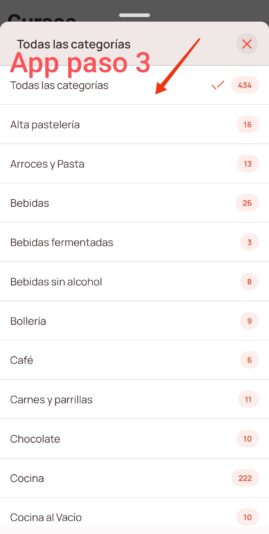Respuestas creadas en el foro
-
Level:
Scoolinary Team
Hola Kattya.
¡Te damos la bienvenida a la comunidad de Scoolinary!
Me puedes ayudar contándome a cuál receta te refieres, así puedo darle un vistazo al material y darte una respuesta a tu consulta.
Saludos.
-
Level:
Scoolinary Team
Hola Kattya.
¡Te damos la bienvenida a la comunidad de Scoolinary!
¿Podrías por favor indicarme cuál es el curso con el que estás teniendo el inconveniente?, así puedo revisarlo y ayudarte a solucionarlo.
Me quedo atenta a tu respuesta.
Saludos.
-
Level:
Scoolinary Team
Hi Brenda.
Welcome to the Scoolinary community!
It’s great to hear that you’re studying vegan pastry,it’s such a fascinating and creative world.
Regarding your question, yes, there are several alternatives you can use instead of potato protein, depending on what you’re trying to achieve (structure, emulsification, moisture retention, etc.).
Here are some common options:
1. Pea protein: Very versatile and widely used in vegan products due to its amino acid profile and overall functionality. It works well for structure and emulsification.
2. Soy protein: Fairly easy to find, though some people choose to avoid it. It’s very functional in doughs and baked goods.
3. Aquafaba: The cooking liquid from chickpeas (or the one in the can). While it’s not high in protein, it mimics the foaming and emulsifying properties of egg whites, making it perfect for meringues, mousses, or light cakes.
4. Lupin protein (or vegetable albumin from lupin): Similar to potato protein in many applications. Although it’s not very common, it’s easier to find in some South American countries.
5. Xanthan gum or guar gum: These aren’t proteins, but they help with structure and moisture retention in gluten-free or vegan products.
I hope this information is helpful! If you have any other questions, feel free to ask I’d be happy to help.
Best regards!
-
Level:
Scoolinary Team
Hola Yorleny.
¡Te damos la bienvenida a la comunidad de Scoolinary!.
Estás en lo correcto y es muy común que uno se confunda con esos términos. Te explico con claridad para que puedas entenderlo con mejor claridad:
Refrigerador (nevera o heladera): es la parte que mantiene los alimentos fríos, normalmente entre 3°C y 5°C. Aquí no se congela el agua (no se hace hielo). Es ideal para dejar reposar la masa de hojaldre durante la noche porque mantiene la mantequilla fría pero no la congela, lo cual permite que la masa se relaje sin volverse quebradiza.
Congelador (freezer): es la parte que congela los alimentos, generalmente a -18°C o menos. Aquí el agua sí se convierte en hielo. Dependiendo si vas usar la masa hojaldre pronto no es recomendable dejarla en congelación a menos que la quieras conservar por más tiempo sin usar. Congelar la masa puede cambiar su textura si no se maneja bien después.
En resumen:
Para dejar reposar la masa hojaldre toda la noche, se usa el refrigerador (la parte donde no se hace hielo). El congelador solo se usa si vas a guardarla por varios días o semanas y no la vas a usar pronto.
Espero que esta información sea de ayuda.
Saludos.
-
Level:
Scoolinary Team
Hola Julián.
¡Te damos la bienvenida a la comunidad de Scoolinary!
La masa filo (o phyllo) es una masa muy fina y delicada de origen mediterráneo y de Medio Oriente, que se usa en recetas como baklava o spanakopita. A diferencia del hojaldre tradicional, no lleva capas de mantequilla entre pliegues, sino que las capas se untan con grasa (mantequilla o aceite) después de estiradas.
Ingredientes básicos para masa filo (aproximadamente 10 hojas grandes):
- 250 g de harina de trigo común (todo uso)
- 1 cucharadita de sal
- 1 cucharadita de vinagre blanco o jugo de limón
- 1 cucharada de aceite de oliva
- 130 ml de agua tibia (puede variar un poco)
- Maicena (fécula de maíz), para espolvorear entre las capas al estirar
Opcional:
- 1 huevo (algunas recetas lo llevan, pero la versión más clásica no)
- Mantequilla o aceite fundido para pincelar entre capas al armar la preparación final
Preparación:
- Mezcla la harina con la sal en un bol. Agrega el vinagre, el aceite y comienza a añadir el agua poco a poco mientras mezclas.
- Amasa durante unos 10-15 minutos hasta que la masa esté suave y elástica. Debe ser lisa, flexible y no pegajosa. Si hace falta, agrega un poquito más de agua o harina.
- Divide la masa en porciones pequeñas (bolitas) y déjalas reposar tapadas con film o paño húmedo durante al menos 1 hora.
- Estira cada porción sobre una superficie espolvoreada con maicena. Usa un rodillo (mejor si es uno delgado tipo rodillo para pasta) para afinar lo más posible cada hoja. Deben quedar tan finas que casi se vean translúcidas.
- Usa inmediatamente o cubre las hojas con un paño húmedo si no las vas a usar enseguida (se secan muy rápido).
Luego puedes usarla en las preparaciónes que gustes ya sean dulces o saladas.
Espero que esta información sea de ayuda.
Saludos.
-
Sussan Estela Olaya
Administradorabril 13, 2025 en 02:32 en respuesta a What's the exact measurement of the ingredients for the croissant ?Level:Scoolinary Team
Hi Batoul.
Welcome to the Scoolinary community!
Just so you know, you can find the recipe books with exact quantities in Chapter 1.
The recipe books are available in both English and Spanish, and they come in PDF format so you can download them.
Here’s the direct link to download the recipe book:
I hope this information is helpful.
Best regards.
-
Sussan Estela Olaya
Administradorabril 12, 2025 en 23:24 en respuesta a I can’t access the lesson videos. There are only short videos. I think the videoLevel:Scoolinary Team
Hi Sebahat.
Welcome to the Scoolinary community!
I see that you have an active subscription,possibly starting yesterday, if I’m not mistaken,so you should be able to access all content without any issues.
Please get in touch with our support team by sending an email to soporte@scoolinary.com. They’ll be able to provide you with all the assistance and information you need.
We recommend attaching a screenshot or image with your message, so the team can better understand what might be happening.
You could also try logging out and signing back in with your username and password, in case it’s a temporary glitch.
Please note that our support team is available Monday through Friday.
If you have any other questions, I’ll be happy to help!
Best regards.
-
Level:
Scoolinary Team
Hi Sahmini.
Welcome to the Scoolinary community!
Iota (iota carrageenan) is a natural gelling agent derived from red algae. It’s known for forming soft, elastic gels in the presence of calcium, making it ideal for preparations like custards where a creamy, cuttable—but not brittle—texture is desired.
Can iota be substituted or omitted?
1. Omitting it completely is not recommended if you want to maintain a firm texture that can be unmolded or served in a glass without being too liquid. Without iota, the mixture will be more like a thickened drink and won’t set into a custard.
2. Possible substitutes:
Agar agar: A plant-based gelling agent that produces a firmer, more brittle gel. If used, the dose needs to be adjusted (about 1 g of agar per 300 ml of liquid) and must be boiled for 1–2 minutes to activate it.
Locust bean gum combined with xanthan gum: This combo can somewhat replicate the elasticity of iota, though it’s trickier to work with and less stable.
Starches (such as cornstarch): You can make a more traditional thick custard using about 15–20 g of cornstarch per 300 ml of soy milk. The result will be more like pastry cream, not a gelled custard as with iota.
In summary:
If you’re aiming for a firm, elastic texture, it’s best to stick with iota.
Omitting it without a replacement is not advised, as the dessert will lose its structure.
Hope this helps!
Best regards.
-
Level:
Scoolinary Team
Hola Johana.
¡Te damos la bienvenida a la comunidad de Scoolinary!
Para preparar masas de panes dulces, bollería y hojaldre en EE. UU., es importante elegir una harina con buen contenido de proteína (alrededor de 11.5% a 12.5%) y con un buen equilibrio entre fuerza y extensibilidad. Aquí te dejo recomendaciones según el uso:
Recomendaciones generales por tipo de masa:
1. Panes dulces y bollería (brioche, pan de leche, etc.):
Busca una harina de fuerza media-alta, con buena capacidad de absorción y desarrollo de gluten.
2. Hojaldre y croissants:
Aquí la harina es clave. Necesitas una harina con un buen balance entre tenacidad y extensibilidad.
Lo ideal para croissants: una harina con un índice de elasticidad PL entre 0.4 y 0.7. Esto garantiza que la masa se pueda estirar bien durante el laminado sin romperse, y que a la vez tenga fuerza para sostener las capas del hojaldrado.
¡Marcas de harina recomendadas en EE. UU.:
-
King Arthur Baking Company
- King Arthur Bread Flour (12.7% proteína): buena para bollería y pan dulce.
- King Arthur All-Purpose Flour (11.7%): en algunos casos se puede usar para croissants si no tienes otra opción, pero no es ideal.
- King Arthur Artisan Flour (Sir Galahad): ideal para viennoiserie, con buena extensibilidad. Disponible en panaderías o distribuidores especializados.
-
Central Milling
- Organic Artisan Bakers Craft Plus o Organic Beehive Flour: tienen buen desarrollo y son muy usadas por panaderos artesanales.
- Piden mínimo por saco de 22 kg, pero es excelente calidad.
-
General Mills – Gold Medal
- Harvest King Bread Flour (12.0%): harina profesional con buen balance. Puedes conseguirla en tiendas especializadas o online.
-
Caputo (italiana, pero disponible en USA)
- Caputo Manitoba Oro o Caputo Cuoco: alto contenido proteico (13%+), ideal para fermentaciones largas, aunque más tenaz (PL alto), útil en mezclas para controlar extensibilidad.
¿Dónde comprar?
Webs como: King Arthur, Janie’s Mill, Central Milling, NYBakers, WebstaurantStore.
Tiendas físicas: Whole Foods, Walmart (limitado), tiendas especializadas en repostería/panadería o distribuidores de restaurantes.
Si vas a hacer croissants o masas hojaldradas, recuerda que además de la harina, la temperatura de trabajo, el laminado correcto y la mantequilla de calidad también son fundamentales.
Espero que esta información sea de ayuda.
Saludos.
-
-
Level:
Scoolinary Team
Hola Neus.
¡Te damos la bienvenida a la comunidad de Scoolinary!
Puedes seguir estos pasos para ver el catálogo de cursos disponibles:
Desde la web:
Dirígete a los tres puntos (…) en el menú. Luego haz clic en “Cursos” y podrás ver todos los cursos disponibles.
Puedes buscarlos por categoría o por nivel. Te adjunto imágenes para que te puedas guiar, junto con el enlace directo:
https://www.scoolinary.com/es/courses
Si estás viendo los cursos desde la app:
Desliza hasta la parte inferior de la pantalla y verás la sección “Cursos”. Haz clic allí y podrás ver y seleccionar los cursos, también organizados por categorías.
(Te adjunto imágenes para que te puedas guiar).
Espero que esta información te sea de ayuda.
Saludos
-
Level:
Scoolinary Team
Hi Rami.
Welcome to the Scoolinary community!
Looking at the image, your croissant has a generally good structure, but the layers in the center are not well defined , it looks a bit dense, as if the layers have merged or didn’t expand properly.
Here are some possible causes and tips to help improve it:
Common reasons for poorly defined layers:
1. Over or under proofing during the final fermentation:
If you overproof, the butter may melt too early and mix into the dough.
If you underproof, the croissant doesn’t build enough strength to allow the layers to expand properly during baking.
Tip: A good sign of proper final proofing is when the croissant has doubled in size and jiggles slightly like gelatin when gently moved. It should also offer little resistance to the touch, without collapsing.
2. Lamination issues (folding and rolling):
If you press too hard while rolling, the layers may stick together.
If the temperature is too warm during lamination, the butter softens too much and blends into the dough.
Tip: Work in an environment between 16–18°C (60–65°F) and use high-quality butter.
3. Oven temperature too low or not enough bottom heat:
If your oven lacks a strong initial heat, the layers won’t rise properly and the croissant will spread outward instead of upward.
Tip: Preheat the oven for 20 to 25 minutes before baking (ideally to 170°C / 340°F). That initial heat boost is key.
4. Incorrect shaping:
If the croissant isn’t rolled tightly from the base, the center can become compressed.
Tip: Make sure to apply tension while rolling, and tuck the tip of the triangle underneath to prevent it from unrolling.
Extra tips:
Use flour with good strength (12–13% protein, with a P/L ratio between 0.4 and 0.7) so the dough can handle the lamination without tearing.
Make sure the butter has a similar plasticity to the dough before incorporating it — not too cold, not too soft.
Hope this helps! If you have any other questions, I’m here and happy to help.
Best regards.
-
Sussan Estela Olaya
Administradorabril 12, 2025 en 03:29 en respuesta a Taking a Class Title off “In Progress”Level:Scoolinary Team
Hi Pamela.
Welcome to the Scoolinary community!
The course you’ve started will always be marked as “in progress” to make it easier to find.
At the moment, we don’t have the option to remove a started course from the “in progress” section.
Thank you for your feedback ,I’ll share it with the team so they can take it into account for future updates.
Best regards.
-
Level:
Scoolinary Team
Hola José.
Por el momento no contamos con la información que nos solicitas. Sin embargo, puedes encontrar más detalles sobre la cocción al vacío en el curso “Cocina al Vacío sin Calor”:
https://www.scoolinary.com/es/courses/cocina-al-vacio-sin-calor
Los capítulos 10 y 11 del curso están dedicados a postres.
Espero que esta información te sea de ayuda.
Saludos.
scoolinary.com
Cocina al Vacío sin Calor: Domina técnicas innovadoras
Tony Botella nos deslumbra con la técnica de cocina al vacío sin aplicar calor. Aprende como hacer hervidos en frío, compactaciones, crudités y más. ¡Entra YA!
-
Sussan Estela Olaya
Administradorabril 12, 2025 en 15:24 en respuesta a Que receta puedo usar para cebollitas encurtidas???Level:Scoolinary Team
Genial Vanessa,aquí estamos por si tienes alguna otra inquietud o pregunta sobre los cursos y con gusto te ayudo a resolverlo.
Saludos.
-
Level:
Scoolinary Team
Great! If you have any other questions, I’ll be here and happy to help.Best regards.










